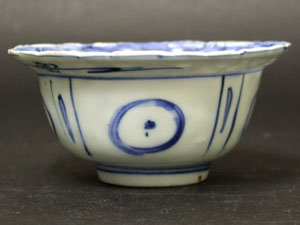
CHONGZHEN PERIOD 1628-1644. Transitional Porcelain.
A Late Ming Dynasty Kraak Porcelain Klapmutsen Bowl. Decorated in Blue and White with `Buddhist Treasures`, the Rim with Four Taotie Masks.
Klapmutsen bowls with high or low sides were a favourite of the Dutch during the first half of the seventeenth century. A shallow Kraak porcelain Klapmutsen such as the present example was ideal for stews and soups, a western pewter spoon could rest on the edge without falling in. V.O.C. records show that Klapmutsen were ordered in four different sizes.
The masks on the rim are referred to as Taotie however Rinaldi points out that these are …”most unlike the traditional Chinese monster mask. Indeed it has a definite resemblance to a gala, the mythological Indian glutton who was punished by having to eat his own body until only the mouth and upper part of the head and two tiny hands remained”. Were the Chinese trying to tell the Dutch something one wonders !
SOLD
- Condition
- Very good, some light fritting.
- Size
- Diameter : 10.4 cm (4 1/4 inches).
- Provenance
- N/A
- Stock number
- 21403
Information
Kraak Porcelain is a Type of Chinese Export Porcelain Produced from the Wanli period (1573-1620) until the end of the Ming Dynasty in the 1640`s. Kraakware or Kraak porcelain was the first Chinese Export Ware to arrive in Europe in large quantities. Its name does not, as had been previously thought derived from the name of Portuguese trading ships, it is possible its name derived from Irish ships called Curachs. These trading ships worked between Ireland and England, they were know to the Dutch traders who used a similar word, craquen, to describe Portuguese trading ships. However in the 16th and early 17th centuries the word Kraak was not used in the V.O.C. record or inventories to describe porcelain. It appears the earliest recorded use of the word Kraak relating to porcelain is in the 1670`s.